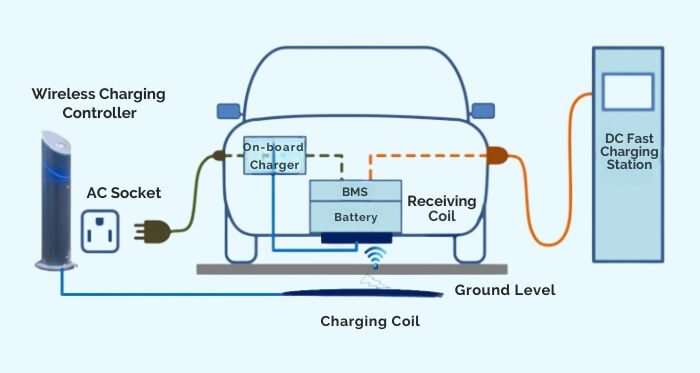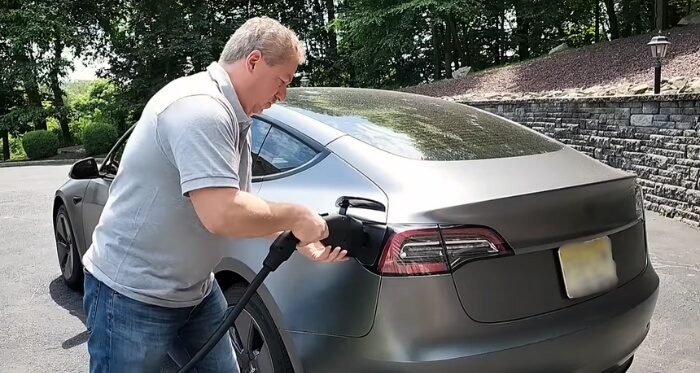From the emergence of EVs in the early 2010s in the Western world with brands like Tesla, Mercedes, etc, a Chinese model of E3W(Electric 3 Wheeler) runs in the terrain of Bangladesh. An unofficial inauguration of EVs in Bangladesh. But in the recent past, to be exact from 2019 the Govt of our country emphasized the use of EVs more here.
So, Learning about the EV charging process becomes essential for potential buyers and customers. While doing that an important query comes in front is “How to unplug an EV charger?” Today we will uncover the facts related to it.
It takes a few important steps to unplug an EV charger. First, stop the EV from charging. Then release the locking mechanism, which is a safety feature available in most EV models. After that gently remove the charging cable to prevent any further damage. Last but not in the list is carefully storing the cable to keep it in good condition.
Learning the unplugging method will help to choose perfect charging stations. Interestingly, Crackplatoon CSL Bangladesh is now manufacturing EV charging stations for EV users here. Continue reading for more info about Crackplatoon’s services, and definitely about the detailed process of unplugging an EV charger. So, let’s dive in!
The Mechanism of EV Charging Setup
The EV charging setup has several key components. First, there’s the EV charging station, also known as an Electric Vehicle Supply Equipment (EVSE). This station is connected to the electrical grid and provides a safe and efficient way to transfer electricity to the EV.

There’s an onboard charger(OBC) located inside the EV. That converts the AC from the EVSE to DC for charging the car’s battery. This process is governed by a control and protection system to ensure safety and efficiency.
The process of interconnectivity between the EV and the EVSE is vital. It defines the correct charging rate and secures the connection. This method adjusts the power flow based on the battery’s current state and EV’s charging capacity.
There are various types of connectors and charging levels. Level 1 and Level 2 chargers use standard AC, while Level 3 chargers, also known as DC fast chargers, provide rapid charging by directly supplying DC to the vehicle.
The Crackplatoon CSL EV charging station has both AC and DC-type chargers for Bangladeshi EV users. The Crackplatoon app has smart charging features, allowing for remote monitoring, control, and integration with renewable energy sources. This intelligent approach optimizes charging times and costs, and can even support the electrical grid during peak times.
The Different Types of Connectors and Their Release Mechanisms
The connector type varies for the EV models. Each has a unique design for a specific EV charging station. They are vital for the compatibility and efficiency of EV charging. As their design is not the same consequently their release mechanism also varies.

So for an EV user, it’s essential to know the subtleties behind the release mechanism of the connector for smooth unplugging from the EV charger. Here we briefly explain the connector types and their release mechanisms for a sound knowledge to unplug EV chargers.
Type 1 Connector
Primarily used in North America for Level 1 and Level 2 charging, Type 1 connectors support single-phase electricity. They are easily identified by their unique shape and pin configuration. The release mechanism is straightforward; a button on the connector unlocks the plug, allowing safe disconnection.
The AMITI21, ALAK48, MIHIR52 are three AC-type charging models from the Crackplatoon that support the Type 1 connectors. The design ensures secure connections during charging, which prevents any accidental disconnections. The position of the unlocking button is ergonomically placed for easy access. Which ensures a consistent and reliable connection, crucial for efficient charging.
Type 2 Connector
Type 2 connectors are popular in Europe and used for both single-phase and three-phase electrical systems. They are versatile, supporting Level 2 and some DC fast charging stations. The release mechanism of these connectors involves a latch that securely locks the connector in place.
By pressing the release button, one can disconnect the type 2 connector easily. While disengaging the latch the process completes. The design ensures secure connections while charging. The mechanism is user-friendly, promoting ease of use and safety. All three models of AC EV charger from Crackplatoons EV charging support Type 2 connectors.
CHAdeMO Connector
For DC fast charging, CHAdeMO connectors are standard. They are commonly found in Japanese EV models. Larger size and shape are their common features. The release mechanism is a bit different, involving a locking handle for secure attachment.
To release a CHAdeMO connector, users must operate the handle, which unlocks the connector from the vehicle. This mechanism ensures a robust connection, essential for high-speed DC charging. It is designed for safety and reliability under rapid charging conditions. The DC Charger of Crackplatoon CSL Bangladesh supports CHadeMo connectors.
CCS Connector
Another DC fast charging connector is named CCS(Combined Charging System, widely used in North America and Europe. It integrates the features of Type 1 or Type 2 with additional DC pins. The release mechanism is similar to that of Type 1 or Type 2, depending on the region.
CCS connectors lock securely during charging and require a button press to release. This ensures a stable connection during the fast charging process. The design prioritizes safety and compatibility across different EV models and charging standards. The Crackplatoon the EV charger supplier of Bangladesh has a DC model that also supports the CCS connector.
These are the different types of connectors found in the EV models and their release mechanisms. Being mindful of their release mechanism will ensure easier unplugging of EV chargers.
How to unplug an EV charger?
EV models require charging after a certain amount of time. Modern EVs run between 100 to 370 miles with a single charge. Some high-end models are pushing limits even further. Whatever the situation is, charging is a need for these vehicles periodically. And unplugging is a natural step in the charging process.
There are certain careful steps to follow for a seamless unplugging of the EV charger. For a safe and durable unplugging, it’s vital to follow these steps mindfully. Any faulty unplugging can lead to hazardous situations for the EV. So, let’s explore how to unplug an EV charger with this comprehensive step-by-step guide.

Step 1: Complete Charging
Wait for the charging process to complete before unplugging from EV charging. The displays show the charging complete indications. This is mostly found in all EV models. So, be alert to recognize the indications in your EV display.
Step 2: Power Off the Charger
Turning off power is the next thing to do before unplugging. Which can be processed via an EV charging station or from a smart app in some cases. It prevents any electrical surges or sparks during disconnection.
Step 3: Press the Release Button
Locate the release button on the EV charger connector. Press it firmly to unlock the connector from the EV’s charging port. This step is crucial to safely detach the connector.
Step 4: Withdraw the Connector
After engaging the release button, carefully pull out the connector out of the charging port. Make sure that you pull it straight to avoid any damage to the port or the connector. Handle the connector with care to maintain its integrity.
Step 5: Secure the Connector
Secure the charger’s connector back to the EV charging station right after the removal of it. For a portable charger, store it in a safe place. This will ensure the safety of the connector from any environmental damage and keep it ready for the next use.
Step 6: Close the Charging Port
Finally, close your EV’s charging port cover. This safeguards the port from dust, water, and debris. It’s an essential step to maintain the cleanliness and functionality of the charging port.
These are the essential steps to unplug an EV charger. By following these steps unplugging the EV charger will be a smooth job for EV users.
The Safety Measures for Unplugging the EV Charger
Your safety is an important factor while unplugging the EV charger. Most of the time a simple unintentional step can lead to massive consequences. So, being mindful of safety measures will make your unplugging smooth and easy. Here, we outline key safety steps to follow when disconnecting your EV from a charging station.

Ensure Charging Completion
Before unplugging, confirm that the EV charging session is fully complete. Premature disconnection can lead to electrical surges, damaging the vehicle’s battery. Most EVs and charging stations provide clear indicators when charging is finished.
Power Off the Charger
Before unplugging, turn off the EV charger. It will reduce the risk of getting any electrical shock and will protect the charging equipment. It’s a fundamental safety step in the disconnection process, ensuring a safe environment.
Proper Use of Release Mechanism
Another safety issue is releasing the charger properly and naturally. Forceful removal without using the release button can damage both the charger and the EV’s charging port. This step is crucial to maintain the integrity of the charging equipment.
Handle Connector Carefully
After disconnection, handle the charging connector with care. Dropping or mishandling it can cause damage, leading to potential safety hazards in future charging sessions. Proper handling is essential for the longevity of the charging equipment.
Inspect for Damage
A periodical inspection is required for both the charger and EV charging port. It will give you a hint of any damaged signs to this equipment. They pose serious risks, including electrical hazards. So, prompt identification and repair of any damage are vital for safe EV charging.
Avoid Charging in Extreme Conditions
The extreme weather conditions are not suitable for EV charging. Avoiding charging while excessive heat, cold, or moisture is suitable for both the EV and the EV chargers. So, if possible avoid charging in these conditions to prevent equipment damage.
These are the safety measures you should remember and be concerned about when unplugging the EV charger. Taking these into account will ensure proper safety during the act of unplugging.
Conclusion
In our comprehensive exploration of “How to unplug an EV charger?”, we dived into the nuances and critical steps involved in this seemingly simple yet essential task. Emphasizing the importance of accuracy mirrors the need for meticulous attention when disconnecting an EV charger.
For Bangladeshi users, we outlined the Crackplatoon EV charging services, a popular EV charger supplier in Bangladesh. Their models are compatible with the different connector types. Highlighting how you unplug the EV charger as a Bangladeshi EV owner.
It’s crucial to follow each step precisely, from ensuring the completion of charging to the careful handling of the connector and port. Just as filling out an application accurately is imperative, so is adhering to the correct sequence of actions to avoid damage to both the vehicle and the charging equipment.
Errors in unplugging, akin to mistakes in important documentation, can lead to inconvenient and potentially costly consequences. This process, while straightforward, underscores the importance of detail and procedure in both daily tasks and broader responsibilities.
